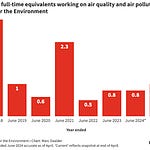
TL;DR: Here’s the top six news items of note in climate news for Aotearoa-NZ this week, and a discussion above between Bernard Hickey and The Kākā’s climate correspondent Cathrine Dyer:
Private industry’s failure to set and maintain course toward sufficient emissions reduction goals provide a backdrop to Microsoft’s recent announcement that it exceeded its emissions reduction goals by more than 30% in 2023 and fully intends to do more of the things that caused the massive overshoot.
Both the Corporate Climate Responsibility Monitor and Green Central Banking suggest that private voluntary actions aren’t working, and that government policy is required to bring financial and commercial efforts into alignment with Paris Agreement goals.
The International Foundation for Valuing Impacts (IFVI) suggests ‘constructive obligations’ by companies to emissions reductions need to be addressed via improved accounting practices. The International Accounting Standards Board agrees with them, while experts in New Zealand contend that this approach should apply to public finances as well.
The potential impact for Aotearoa-New Zealand of failing to meet ‘constructive obligations’ are highlighted by this new report from The Aotearoa Circle and Chapman Tripp.
More broadly, complacency about the economic and financial damages that will result from climate change and biodiversity loss are creating risk bubbles throughout the global economy and bear a large share of responsibility for the slow pace of the transition. Two recent reports have started introducing some reality to economic climate modelling. While the financial system must vastly improve its understanding of climate impacts, a big question mark hangs over the whole idea financial disclosures will make a difference. Just how much reality can the global financial system bear without collapsing?
The shocking injuries this week to 20 passengers and the death (by heart attack) of one person on a Singapore Airlines flight that encountered severe turbulence over the Irrawaddy Basin in Myanmar are another data point in signs climate change is increasing turbulence at high altitudes used by commercial jet liners, as Bloomberg (gift) and The Conversation referred to this week.
(See more detail and analysis below, and in the video and podcast above. Cathrine Dyer’s journalism on climate and the environment is available free to all paying and non-paying subscribers to The Kākā and the public. It is made possible by subscribers signing up to the paid tier to ensure this sort of public interest journalism is fully available in public to read, listen to and share. Cathrine wrote the wrap. Bernard edited it. Lynn copy-edited and illustrated it.)
Voluntary targets and initiatives completely insufficient
Microsoft has announced it exceeded its emissions reduction targets by more than 30% in 2023. The rise in their Scope 3 emissions (indirect emissions in their supply chain) relate primarily to the construction of more data centres used for cloud computing and to deliver their developing AI services. In response, Microsoft plans to build more data centres, claiming that they will be more efficient, use more renewable energy and will help to produce technological breakthroughs. As Euronews reports:
“As well as greening its energy supplies, Microsoft is working to improve efficiency in its data centres. It says AI will play an important role in helping to increase accountability and achieve technology breakthroughs - which it hopes will extend to developing greener steel, concrete and fuels, as well as reducing water usage.”
That Microsoft is transparent about its failure to meet its own net-zero goals is creditable, but the response to that failure is worrying.
It is offering up a set of false solutions, heavily buttressed by baseless technological optimism. According to the Jevons Paradox, technological progress that increases efficiency can lead to an overall rise in resource use as reduced pricing resulting from efficiency gains stimulates demand.
While Microsoft intends to source its increasing energy demands from renewable sources, the world is already struggling to increase renewable energy supply faster than the overall increase in demand for energy. It is worth bearing in mind that it is not a renewable energy transition unless the growth in renewable energy replaces, rather than supplements fossil energy. Thus, Microsoft’s increasing energy demand could stall or slow the overall energy transition, irrespective of where it sources its own energy. Microsoft is also utilising carbon capture and storage technology in its plans to reduce net emissions.
According to the recently released Corporate Climate Responsibility Monitor 2024, Microsoft is not alone in its failure to put together a feasible plan for achieving zero carbon targets. While the report found a slight improvement in companies’ targets, they still fall well short of the emissions reductions required by UN agreements, and most are ambiguous, commit to only limited emissions reductions and are at risk of backsliding under proposed rule changes related to the use of carbon credits.
“Another concerning trend highlighted in the report is companies’ reliance on false solutions to reduce emissions, which diverts attention from the necessary level of action implied in their net-zero or carbon neutrality pledges. [...] Examples of false solutions include carbon capture and storage in the power sector, excessive reliance on temporary carbon dioxide sequestration in the agriculture sector and the use of unsustainable bioenergy instead of renewable electricity in the fashion sector, according to the report.”
Overall, the report found the none of the 51 companies covered had climate strategies that could be considered ‘high integrity’.
Another study by net Zero Tracker (an independent data consortium including Oxford University) found that while half of the world’s 2,000 largest listed companies had a net-zero by 2050 target, just 4% of them met the criteria outlined by the U.N.’s Race to Zero campaign.
Both the Corporate Climate Responsibility Monitor and this report from Green Central Banking suggest voluntary targets in the banking and other commercial sectors are proving completely insufficient and that government policy is required to force them into alignment with Paris Agreement goals. According to Green Central Banking’s report:
“This evidence supports recent efforts by governments to improve the credibility of net zero commitments. More broadly, it suggests that voluntary private-sector initiatives may have relatively little impact on decarbonization.”
Calls for accounting overhaul on climate obligations
The International Foundation for Valuing Impacts (IFVI) says the accounting treatment of investments to reduce carbon emissions, as costs on companies’ balance sheets, while the failure to reduce emissions are treated as externalities, is “illogical and just feels like bad accounting”. What they describe as ‘upside down incentives’ are they claim, the “true root cause of the systemic inability to tackle the climate and biodiversity crises”.
They say that companies’ stated commitments to reducing emissions create expectations that their targets will actually be met, and these should be recognised on their books as ‘constructive obligations’. This approach is known as Impact Accounting. The IFVI suggests the treatment of constructive obligations be made a required issue for independent board governance that demands the creation of an impact analysis for the company and its investors as a first step. The international Accounting Standards Board agrees with them, deciding recently that corporate targets could create direct financial consequences on companies’ balance sheets.
“The decision makes two key clarifications. First, that a climate target does not have to be legally enforceable to matter: even an entirely voluntary target can create a financial obligation if the company is sufficiently committed to its delivery (that is, there can be a ‘constructive obligation’ in accounting-speak).
Second, when use of carbon credits is part of meeting a target (offsetting a company’s excess annual emissions), the cost of those credits should be financially provisioned for, as a liability, when the emissions occur each year.”
According to experts Rob Morrison and Dr Christina Hood in this Newsroom article, that obscure accounting decision has implications for Aotearoa-New Zealand’s public accounting of climate commitments as well. They suggest that the growing gap in the country’s international climate commitments, which must be met through the purchase of offshore carbon credits, represents a constructive obligation that should be recorded in Treasury’s accounts.
According to Treasury estimates, that current obligation could amount to as much as NZ$9 billion dollars, depending on how it is met. One key reason for keeping track of that obligation is that government policy-making (or policy dismantling, as the case may be) across multiple sectors can either ameliorate that gap or tear it right open. It is a substantial problem that these obligations are currently invisible to the public, because they are treated by Treasury as if they are voluntary payments and not obligations.
Just how problematic that treatment could prove to be is the subject of another recent report, this time from The Aotearoa Circle and Chapman Tripp. This report explores the potentially serious impacts that failing to fulfil those ‘constructive obligations’ could have on New Zealand’s export markets by way of increasing financial disclosure regimes and border adjustment processes in other countries. Our climate commitments represent ‘constructive obligations’ precisely because these damaging impacts would materialise if we didn’t meet them. They are not merely ‘voluntary’ payments that could be avoided without consequence should the government elect to resile from them.
Risk bubbles abound, but complacency rules
Complacency about the true costs of neglecting to invest in climate mitigation or biodiversity loss abounds in the financial system and is creating enormous risk bubbles that threaten the stability of the entire system. Yet another example is contained in this recent report from University College London’s (UCL) Institute for Innovation and Public Purpose.
The report attempts to improve the understanding of the risks to the global economy and financial system that would be caused by the crossing of ecological thresholds or tipping points.
The enormous potential scale of economic losses is currently poorly understood, and requires a precautionary approach, according to the report writers, if governments are to maintain price and financial stability. The consequences of crossing tipping points are barely (if at all) considered in current economic climate modelling, yet multiple tipping points are expected to be crossed under current pathways which anticipate warming of 2.5 to 3.0˚C by 2100.
This report falls directly on top of another recent publication suggesting that climate damages in current economic modelling are underestimated by as much as 600%. In both cases, the report writers suggest that true costs are likely to be even higher than is currently understood.
This poses a question as to whether the current financial system is even capable of sustaining the size of adjustment that would be necessary for it to be treating the risks associated with climate damage and biodiversity loss in a way that is close to realistic.
To the extent that it does not, or cannot, then the course of future global economic development will remain littered with enormous risk bubbles around every corner, continuously threatening the stability of the system.
Some Substack recommendations
In other news, I recently discovered Henry Cooke’s substack Museum Street. This discussion about the future of the Ministry for the Environment (MfE) makes for interesting reading, as does this riveting piece from last year, where MfE disagreed with the Ministry for Primary Industries’(MPIs) conclusion that climate change would make Aotearoa New Zealand richer! Also on substack, Adam Tooze over on Chartbook has a good look at the progress of the global energy transition, which is essentially the same thing as looking at the progress of China’s energy transition.
Ka kite ano
Bernard and Cathrine















How much climate reality can the global financial system take without collapsing?